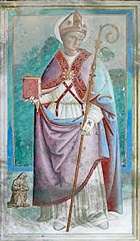

Tiberio Ranieri di Diotallevi, usually known as Tiberio d’ Assisi, was first documented in Assisi in 1486, when he became a member of the Confraternita di San Vitale. He probably trained under Pintoricchio, and may well have accompanied him to Rome to work in Santa Maria del Popolo (1485–9) and in the Borgia apartments in the Vatican Palace (ca. 1492–5). He is documented as a painter in Perugia and in Assisi in the 1490s, although no securely attributed work from this period survives. An altarpiece (1502) in the Pinacoteca Vaticana, which depicts the Madonna and Child enthroned with SS Jerome and Francis, is attributed to him.
In a contract of 1504, the Commune of Assisi commissioned him to paint the arms of Pope Julius II, describing him somewhat effusively in the contract as “sublimis et quasi divinus pictor” (sublime and almost divine painter). He served on the City Council in 1516.
Assisi
Pietà (late 15th century)
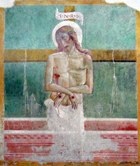
Madonna and Child with St Francis (15th century)
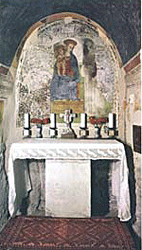
Frescoes from Fonte di Moiano (ca. 1500)
A number of frescoes from a site near the Fonte di Moiano are known from documents. The surviving fragments in the Pinacoteca Comunale are attributed to Tiberio d' Assisi:
-
✴Madonna and Child
-
This damaged fresco fragment, which depicts the Madonna and Child with two seraphim, came from large scene that was documented in 1835 as a Madonna and Child enthroned, set in a landscape. One source says that it was above the gate leading to an orchard belonging to the Confraternita di San Crispino.
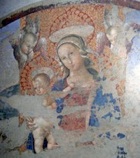
-
✴St Rufinus
-
This fresco of a bishop saint, probably St Rufinus, was documented here in 1835, along with two others that no longer survive: another bishop saint and St Francis.
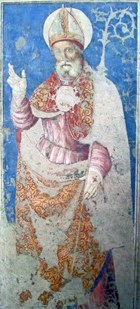
Madonna and Child with saints (ca. 1500)

This fresco, which is attributed to Tiberio d' Assisi, was detached from the arch across the Vicolo Arco di Sant' Antonio (see Walk II) and is now in the Pinacoteca Comunale. It depicts the Madonna and Child with St Francis and another (damaged) saint (presumably St Antony of Padua).
Pietà (1508)
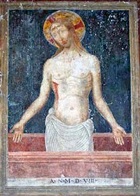
Crucifixion with saints (ca. 1509)
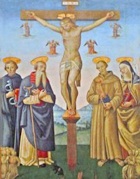
Frescoes of the Cappella delle Rose, Santa Maria degli Angeli
A grill separates the Cappella delle Rose into two spaces, both of which contain frescoes by Tiberio d’ Assisi:
-
✴St Bonaventure commissioned the rear part of the chapel in ca. 1260, and it was enlarged or rebuilt in 1344.
-
✴St Bernardino of Siena commissioned the oratory in front of it in the early 15th century.
Frescoes of the Rear Chapel (1506)
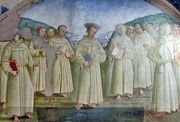
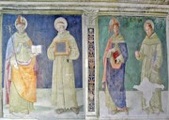


These frescoes, which are attributed to Tiberio d' Assisi, depict:
-
✴St Francis and his first twelve companions (on the back wall, above the opening of St Francis’ cell);
-
✴SS Bonaventure, Bernardino of Siena, Louis of Toulouse and Antony of Padua (on the left);
-
✴God the Father (in the vault); and
-
✴SS Clare and Elizabeth of Hungary (on the right).
Frescoes of the Oratory (1516)
These frescoes, which are also attributed to Tiberio d' Assisi, depict the granting of the Portiuncula Indulgence. Tiberio re-used a number of the scenes from the cycle that he had painted in the Cappella delle Rose in San Fortunato, Montefalco in 1512.
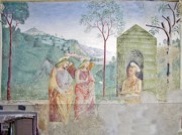
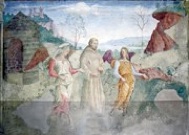
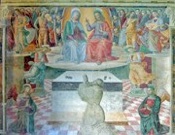
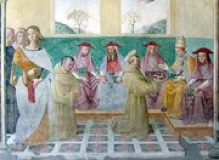
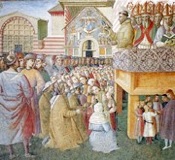
In these scenes:
-
✴angels appears to St Francis as he rolls in rose bushes to ward off temptation;
-
✴the angels guide him to the Portiuncula;
-
✴Christ grants the Portiuncula Indulgence;
-
✴Pope Honorius III confirms the Portiuncula Indulgence; and
-
✴the Portiuncula Indulgence is proclaimed outside the church. The last scene shows the Portiuncula as it was in the early 16th century. Among the bishops behind St Francis is St Raynald, Bishop of Nocera, who wears a beard as required by his status as a monk from Fonte Avellana.
Frescoes in San Damiano (1517-23)
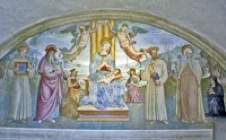
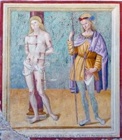
The Cappella di San Girolamo of San Damiano contains two frescoes that are attributed to Tiberio d' Assisi. Inscriptions record that:
-
✴Galeotto de' Bistochi commissioned the fresco (1517) in the lunette of the altar wall, which depicts the Madonna and Child with SS Bernardino, Jerome, Francis and Clare; and
-
✴Sante di Santorello commissioned the fresco (1523) of SS Sebastian and Roch on the left wall.
Bettona
Trinity and St Roch (ca. 1503)
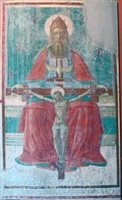

These two frescoes, which are attributed to Tiberio d’ Assisi, were detached from the ruined church of San Simeone, Tor d’ Andrea (on the borders with Assisi) in the early 20th century and are are now in the Pinacoteca Civica.
-
✴In the Trinity, the seated God the Father holds a Crucifix, with the Holy Spirit in the form of a dove above it. A now-lost inscription of the date “1503” was recorded on it in the 19th century.
-
✴In the other fresco, the standing St Roch is dressed as a pilgrim and displays the scars from the plague on his thigh.
Montefalco
Madonna and Child with saints (1510)
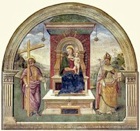
Madonna del Soccorso (1510)

The panel depicts the Madonna clubbing the Devil, who is trying to possess a child. The kneeling donor is presumably Griseida, and the child is presumably her son.
Frescoes (1512)
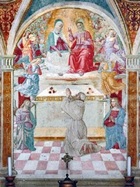
-
✴five scenes from the story of the granting of the Portiuncula Indulgence, including the central scene illustrated here;
-
✴Franciscan saints;
-
✴God the Father (in the vault); and
-
✴the Pietà, on the altar frontal.
St Sebastian (ca. 1512)
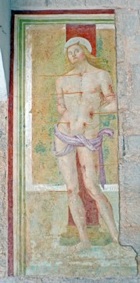
Perugia
Tiberio d’ Assisi was employed in the Duomo, Perugia in 1495, 1501 and 1506. He received payment, along with Fiorenzo di Lorenzo, from the monks of San Pietro in 1504.
Madonna and Child with saints (ca. 1500)
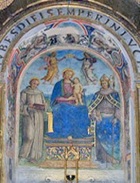
Madonna and Child (ca. 1502)
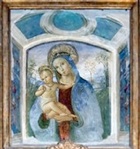
The sides of the niche are decorated with frescoes candelabra. The original fresco of the upper tondo has been lost.
Spello
St Antony Abbot (1518)
This altarpiece in San Lorenzo, which is attributed to Tiberio d’ Assisi, is dated by inscription.
Trevi
Madonna and Child with angels (16th century)
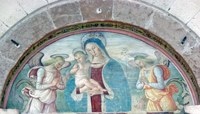
This fresco, which is signed by Tiberio d' Assisi, is in the lunette above the entrance to San Martino. The inscription also records that it was commissioned by "Ioannes Baptista Mag... de Trevio".
St Martin (16th century)
This detached fresco in the presbytery of San Martino, which depicts St Martin sharing his cloak with a beggar, is attributed to Tiberio d' Assisi.
St Emilianus (16th century)
